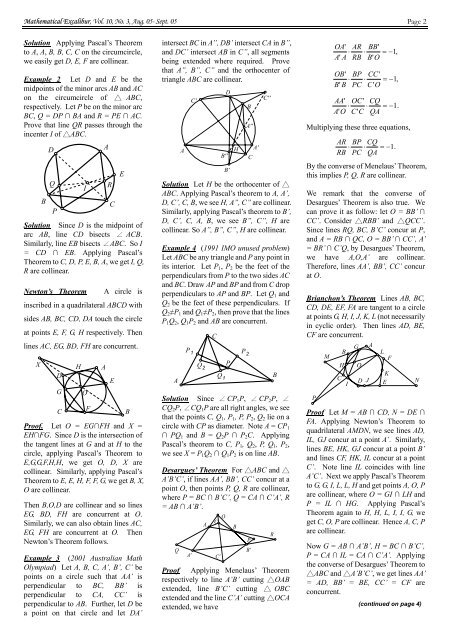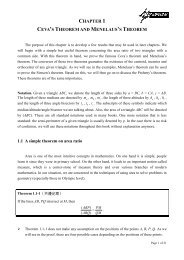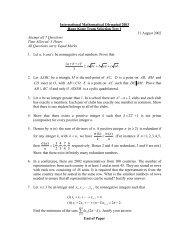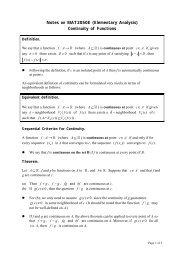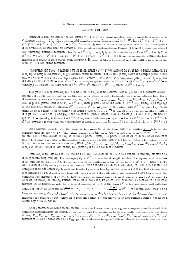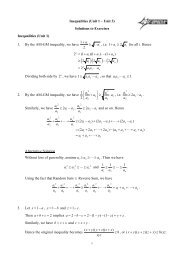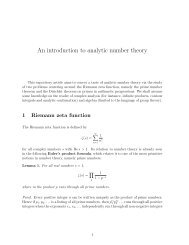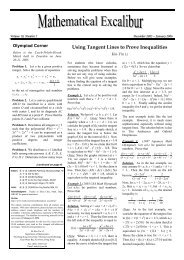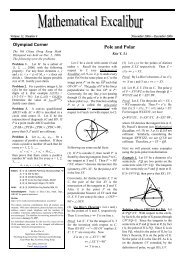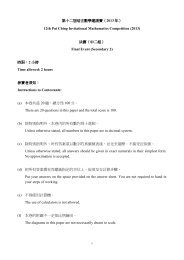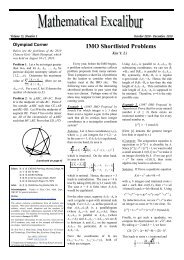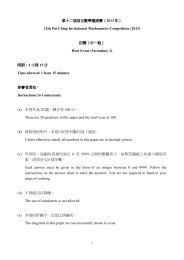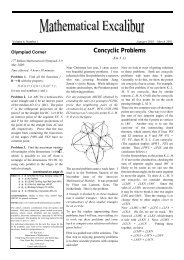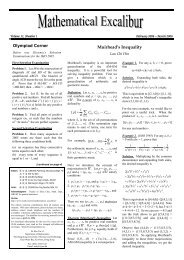Famous Geometry Theorems - Department of Mathematics - The ...
Famous Geometry Theorems - Department of Mathematics - The ...
Famous Geometry Theorems - Department of Mathematics - The ...
You also want an ePaper? Increase the reach of your titles
YUMPU automatically turns print PDFs into web optimized ePapers that Google loves.
Mathematical Excalibur, Vol. 10, No. 3, Aug. 05- Sept. 05 Page 2<br />
Solution Applying Pascal’s <strong>The</strong>orem<br />
to A, A, B, B, C, C on the circumcircle,<br />
we easily get D, E, F are collinear.<br />
Example 2 Let D and E be the<br />
midpoints <strong>of</strong> the minor arcs AB and AC<br />
on the circumcircle <strong>of</strong> △ ABC,<br />
respectively. Let P be on the minor arc<br />
BC, Q = DP ∩ BA and R = PE ∩ AC.<br />
Prove that line QR passes through the<br />
incenter I <strong>of</strong> △ABC.<br />
B<br />
D<br />
Q<br />
P<br />
I<br />
Solution Since D is the midpoint <strong>of</strong><br />
arc AB, line CD bisects ∠ ACB.<br />
Similarly, line EB bisects ∠ABC. So I<br />
= CD ∩ EB. Applying Pascal’s<br />
<strong>The</strong>orem to C, D, P, E, B, A, we get I, Q,<br />
R are collinear.<br />
Newton’s <strong>The</strong>orem<br />
A<br />
R<br />
C<br />
E<br />
A circle is<br />
inscribed in a quadrilateral ABCD with<br />
sides AB, BC, CD, DA touch the circle<br />
at points E, F, G, H respectively. <strong>The</strong>n<br />
lines AC, EG, BD, FH are concurrent.<br />
X<br />
D<br />
G<br />
C<br />
H<br />
O<br />
Pro<strong>of</strong>. Let O = EG∩FH and X =<br />
EH∩FG. Since D is the intersection <strong>of</strong><br />
the tangent lines at G and at H to the<br />
circle, applying Pascal’s <strong>The</strong>orem to<br />
E,G,G,F,H,H, we get O, D, X are<br />
collinear. Similarly, applying Pascal’s<br />
<strong>The</strong>orem to E, E, H, F, F, G, we get B, X,<br />
O are collinear.<br />
<strong>The</strong>n B,O,D are collinear and so lines<br />
EG, BD, FH are concurrent at O.<br />
Similarly, we can also obtain lines AC,<br />
EG, FH are concurrent at O. <strong>The</strong>n<br />
Newton’s <strong>The</strong>orem follows.<br />
Example 3 (2001 Australian Math<br />
Olympiad) Let A, B, C, A’, B’, C’ be<br />
points on a circle such that AA’ is<br />
perpendicular to BC, BB’ is<br />
perpendicular to CA, CC’ is<br />
perpendicular to AB. Further, let D be<br />
a point on that circle and let DA’<br />
F<br />
A<br />
E<br />
B<br />
intersect BC in A’’, DB’ intersect CA in B’’,<br />
and DC’ intersect AB in C’’, all segments<br />
being extended where required. Prove<br />
that A’’, B’’, C’’ and the orthocenter <strong>of</strong><br />
triangle ABC are collinear.<br />
A<br />
C'<br />
B''<br />
D<br />
B'<br />
H<br />
B<br />
A''<br />
C<br />
A'<br />
C''<br />
Solution Let H be the orthocenter <strong>of</strong> △<br />
ABC. Applying Pascal’s theorem to A, A’,<br />
D, C’, C, B, we see H, A’’, C’’ are collinear.<br />
Similarly, applying Pascal’s theorem to B’,<br />
D, C’, C, A, B, we see B’’, C’’, H are<br />
collinear. So A’’, B’’, C’’, H are collinear.<br />
Example 4 (1991 IMO unused problem)<br />
Let ABC be any triangle and P any point in<br />
its interior. Let P 1 , P 2 be the feet <strong>of</strong> the<br />
perpendiculars from P to the two sides AC<br />
and BC. Draw AP and BP and from C drop<br />
perpendiculars to AP and BP. Let Q 1 and<br />
Q 2 be the feet <strong>of</strong> these perpendiculars. If<br />
Q 2 ≠P 1 and Q 1 ≠P 2 , then prove that the lines<br />
P 1 Q 2 , Q 1 P 2 and AB are concurrent.<br />
A<br />
C<br />
P 1 P 2<br />
Q 2<br />
Q 1<br />
Solution Since ∠ CP 1 P, ∠ CP 2 P, ∠<br />
CQ 2 P, ∠CQ 1 P are all right angles, we see<br />
that the points C, Q 1 , P 1 , P, P 2 , Q 2 lie on a<br />
circle with CP as diameter. Note A = CP 1<br />
∩ PQ 1 and B = Q 2 P ∩ P 2 C. Applying<br />
Pascal’s theorem to C, P 1 , Q 2 , P, Q 1 , P 2 ,<br />
we see X = P 1 Q 2 ∩ Q 1 P 2 is on line AB.<br />
Desargues’ <strong>The</strong>orem For △ABC and △<br />
A’B’C’, if lines AA’, BB’, CC’ concur at a<br />
point O, then points P, Q, R are collinear,<br />
where P = BC ∩ B’C’, Q = CA ∩ C’A’, R<br />
= AB ∩ A’B’.<br />
Q<br />
A'<br />
A<br />
C<br />
C'<br />
O<br />
Pro<strong>of</strong> Applying Menelaus’ <strong>The</strong>orem<br />
respectively to line A’B’ cutting △OAB<br />
extended, line B’C’ cutting △ OBC<br />
extended and the line C’A’ cutting △OCA<br />
extended, we have<br />
P<br />
B<br />
P<br />
B'<br />
R<br />
B<br />
OA'<br />
⋅<br />
A'<br />
A<br />
OB'<br />
⋅<br />
B'<br />
B<br />
AR<br />
RB<br />
BP<br />
PC<br />
BB'<br />
⋅ = −1,<br />
B'<br />
O<br />
CC'<br />
⋅ = −1,<br />
C'<br />
O<br />
AA ' OC'<br />
CQ<br />
⋅ ⋅ = −1.<br />
A'<br />
O C'<br />
C QA<br />
Multiplying these three equations,<br />
AR<br />
RB<br />
⋅<br />
BP CQ<br />
⋅ = −1.<br />
PC QA<br />
By the converse <strong>of</strong> Menelaus’ <strong>The</strong>orem,<br />
this implies P, Q, R are collinear.<br />
We remark that the converse <strong>of</strong><br />
Desargues’ <strong>The</strong>orem is also true. We<br />
can prove it as follow: let O = BB’ ∩<br />
CC’. Consider △RBB’ and △QCC’.<br />
Since lines RQ, BC, B’C’ concur at P,<br />
and A = RB ∩ QC, O = BB’ ∩ CC’, A’<br />
= BR’ ∩ C’Q, by Desargues’ <strong>The</strong>orem,<br />
we have A,O,A’ are collinear.<br />
<strong>The</strong>refore, lines AA’, BB’, CC’ concur<br />
at O.<br />
Brianchon’s <strong>The</strong>orem Lines AB, BC,<br />
CD, DE, EF, FA are tangent to a circle<br />
at points G, H, I, J, K, L (not necessarily<br />
in cyclic order). <strong>The</strong>n lines AD, BE,<br />
CF are concurrent.<br />
P<br />
M<br />
C<br />
B<br />
H<br />
I<br />
G<br />
O<br />
D<br />
J<br />
A<br />
L<br />
F<br />
K<br />
E<br />
Pro<strong>of</strong> Let M = AB ∩ CD, N = DE ∩<br />
FA. Applying Newton’s <strong>The</strong>orem to<br />
quadrilateral AMDN, we see lines AD,<br />
IL, GJ concur at a point A’. Similarly,<br />
lines BE, HK, GJ concur at a point B’<br />
and lines CF, HK, IL concur at a point<br />
C’. Note line IL coincides with line<br />
A’C’. Next we apply Pascal’s <strong>The</strong>orem<br />
to G, G, I, L, L, H and get points A, O, P<br />
are collinear, where O = GI ∩ LH and<br />
P = IL ∩ HG. Applying Pascal’s<br />
<strong>The</strong>orem again to H, H, L, I, I, G, we<br />
get C, O, P are collinear. Hence A, C, P<br />
are collinear.<br />
Now G = AB ∩ A’B’, H = BC ∩ B’C’,<br />
P = CA ∩ IL = CA ∩ C’A’. Applying<br />
the converse <strong>of</strong> Desargues’ <strong>The</strong>orem to<br />
△ABC and △A’B’C’, we get lines AA’<br />
= AD, BB’ = BE, CC’ = CF are<br />
concurrent.<br />
N<br />
(continued on page 4)


